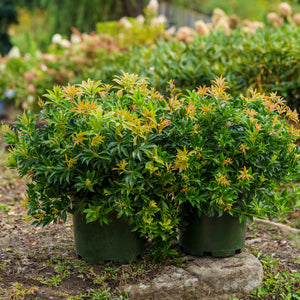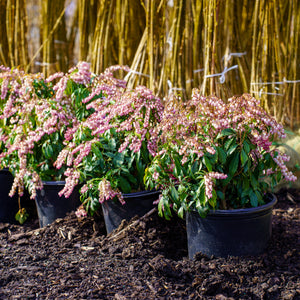The Pieris Guide
Pieris (Pieris spp.), also known as andromeda or lily-of-the-valley shrub, are evergreen broadleaf shrubs appreciated for their cascading spring flowers, colorful new foliage, and year-round structure. Native to eastern Asia and parts of the southeastern United States, Pieris are closely related to rhododendrons and azaleas, thriving in similar acidic soil conditions. Their refined appearance, manageable size, and multi-season interest make them popular additions to woodland gardens and shaded borders.
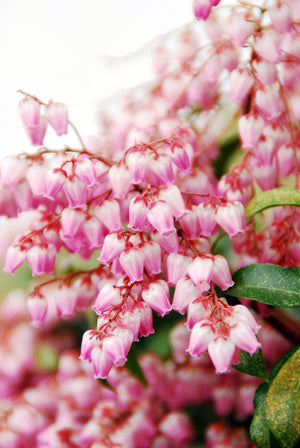
About
Pieris japonica is the most commonly cultivated species and is available in a wide array of cultivars that vary in height, leaf color, and flower presentation. These shrubs typically bloom in early to mid-spring with delicate, bell-shaped flowers in white, pink, or cream tones that hang in pendulous clusters.
Notable cultivars include:
- ‘Mountain Fire’ – Red new growth and profuse white flowers.
- ‘Dorothy Wycoff’ – Deep pink buds that open to pale pink flowers.
- ‘Cavatine’ – A compact dwarf variety perfect for small spaces.
- ‘Flaming Silver’ – Striking variegated foliage with pink new growth.
- ‘Prelude’ – Early blooming and ideal for foundation plantings.
- ‘Scarlett O’Hara’ – Vigorous and upright with showy blooms and red new foliage.
- ‘Enchanted Forest Impish Elf’ – A compact form with colorful foliage and early spring flowers.
Pieris shrubs are slow to moderate growers but reward gardeners with long-lasting interest from spring into winter. Their evergreen foliage and neat form add structure to shaded garden spaces.
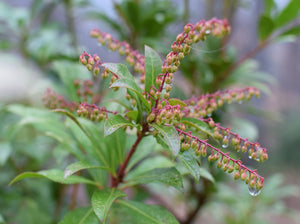
PLANTING
Proper planting ensures a healthy, long-lived Pieris that thrives in its site and performs well throughout the year.
USDA Hardiness Zones: Most varieties are hardy in Zones 5–8, with some selections tolerating Zone 4 with protection.
Soil: Pieris prefer acidic, well-drained, organically rich soils. They do poorly in alkaline or compacted soil. Amending with peat moss or compost can help.
Sunlight: Partial shade is ideal. While they can tolerate full sun in cool climates, they perform best in dappled shade or morning sun with afternoon protection.
Watering: Keep soil consistently moist during establishment. Once established, they tolerate short dry spells but prefer evenly moist conditions.
Spacing: Space plants according to mature size. Dwarf varieties like ‘Cavatine’ may be spaced 2–3 feet apart, while larger types such as ‘Mountain Fire’ need 4–6 feet.
Planting Time: Early spring or fall is best. Avoid planting in summer heat to reduce transplant shock.

CARE
Watering: Provide consistent moisture, especially during dry periods. Avoid letting the soil dry out completely or become soggy.
Fertilizing: Use an acid-loving plant fertilizer in early spring. Avoid high-nitrogen fertilizers, which can reduce flowering.
Pruning: Light pruning after flowering helps maintain shape and encourage bushiness. Remove dead or damaged wood at any time. Pieris do not require heavy pruning and respond well to gentle shaping.
Pests and Diseases: Watch for lacebugs, especially in full sun. Leaf spot and root rot can occur in poorly drained sites. Encourage airflow and maintain healthy soil to prevent issues.
Mulching: Apply 2–3 inches of mulch to conserve moisture and moderate soil temperature. Keep mulch a few inches from the main stem to avoid rot.
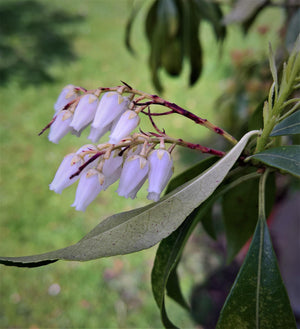
HOW TO USE
Focal Point: Varieties like ‘Mountain Fire’ or ‘Scarlett O’Hara’ serve as stunning focal points thanks to their fiery red new growth and elegant flower clusters. Use them near entrances or as anchor shrubs in shaded beds.
Woodland Gardens: Pieris pairs well with other acid-loving, shade-tolerant plants like azaleas, rhododendrons, hellebores, and ferns. Their graceful form and evergreen foliage help blend plantings and fill in the understory.
Foundation Plantings: Compact types such as ‘Cavatine’ and ‘Prelude’ are excellent for foundation beds and under windows. Their neat size and evergreen foliage provide structure and color year-round.
Mixed Shrub Borders: Combine Pieris with boxwood, hydrangea, or leucothoe for contrast in foliage and bloom time. The varied textures enhance seasonal interest and help tie together different garden layers.
Container Gardens: Dwarf Pieris varieties thrive in large pots with acidic soil mixes. Use them in shady patios or entryways for elegant, manageable displays.
Seasonal Displays: The vivid red or bronze new growth on many cultivars adds spring interest even before flowers emerge. Position them where you can enjoy this show from walkways or windows.
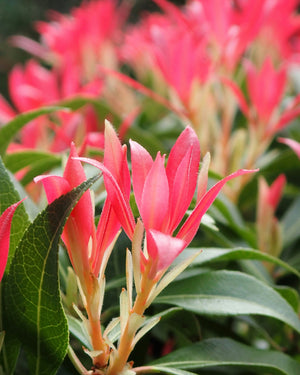
Common Questions
Is Pieris deer resistant? Pieris is generally considered deer resistant due to its leathery, bitter-tasting foliage.
How to prune Pieris? Lightly prune after flowering to shape and control size. Avoid hard pruning into old wood.
When to prune Pieris? Late spring, just after flowering, is the best time for shaping and maintenance.
Is Pieris toxic to dogs? Yes, all parts of the Pieris plant are considered toxic to dogs if ingested.
Is Pieris toxic to cats? Yes, Pieris contains grayanotoxins and is toxic to cats.
Are Pieris evergreen? Yes, Pieris is a broadleaf evergreen that retains its foliage year-round.
Can Pieris be cut back hard? Pieris does not respond well to hard pruning; only rejuvenate cautiously and over several seasons.
How big do Pieris grow? Most cultivars reach 3 to 8 feet tall and wide, but dwarf varieties stay under 3 feet.
How fast does Pieris grow? Pieris has a slow to moderate growth rate, typically gaining 6-12 inches per year.
Do rabbits eat Pieris? Rabbits typically avoid Pieris, though young shrubs may need protection until established.
How big do Pieris get? Mature size varies by cultivar. Dwarf forms like ‘Lil Heath’ stay around 2–3 feet tall, while larger varieties can reach 6–10 feet tall and wide.
Conclusion
Pieris offers four-season appeal with spring blooms, vibrant new growth, and evergreen foliage that adds elegance and structure to shaded gardens. With a wide range of sizes and colors, Pieris is a versatile, low-maintenance shrub that elevates woodland landscapes, foundation beds, and mixed borders. By selecting the right cultivar and providing acidic soil and partial shade, gardeners can enjoy decades of beauty and performance from this refined evergreen.
The Pieris Collection
Sold Out

